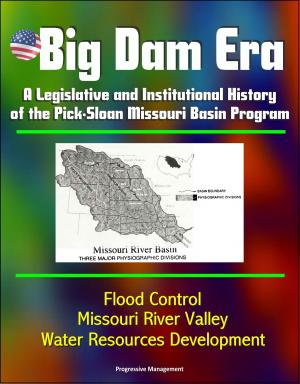Earthquake Risks from Enhanced Geothermal Systems (EGS): Induced Seismicity from Geothermal Energy, Addressing Public Concerns, Expert Panel Protocols
Nonfiction, Science & Nature, Technology, Power Resources, Science, Earth Sciences| Author: | Progressive Management | ISBN: | 9781476145105 |
| Publisher: | Progressive Management | Publication: | March 15, 2012 |
| Imprint: | Smashwords Edition | Language: | English |
| Author: | Progressive Management |
| ISBN: | 9781476145105 |
| Publisher: | Progressive Management |
| Publication: | March 15, 2012 |
| Imprint: | Smashwords Edition |
| Language: | English |
Featuring a 2012 Department of Energy (DOE) report, this ebook provides important official information on the risk of earthquakes, called induced seismicity, from enhanced geothermal systems (EGS) technology projects. The preface to the "Protocol for Addressing Induced Seismicity Associated with Enhanced Geothermal Systems" states:
In June 2009, the New York Times published an article about the public fear of geothermal development causing earthquakes. The article highlighted a project funded by the U.S. Department of Energy's (DOE) Geothermal Technologies Program bringing power production at The Geysers back up to capacity using Enhanced Geothermal Systems (EGS) technology. The Geysers geothermal field is located two hours north of San Francisco, California, and therefore, the article drew comparisons to a similar geothermal EGS project in Basel, Switzerland believed to cause a magnitude 3.4 earthquake.
In order to address public concern and gain acceptance from the general public and policymakers for geothermal energy development, specifically EGS, the U.S. Department of Energy commissioned a group of experts in induced seismicity, geothermal power development and risk assessment to write a revised Induced Seismicity Protocol. The authors met with the domestic and international scientific community, policymakers, and other stakeholders to gain their perspectives and incorporate them into the Protocol. They also incorporated the lessons learned from Basel, Switzerland and other EGS projects around the world to better understand the issues associated with induced seismicity in EGS projects. The Protocol concludes that with proper study and technology development induced seismicity will not only be mitigated, but will become a useful tool for reservoir management.
This Protocol is a living guidance document for geothermal developers, public officials, regulators and the general public that provides a set of general guidelines detailing useful steps to evaluate and manage the effects of induced seismicity related to EGS projects. This Protocol puts high importance on safety while allowing geothermal technology to move forward in a cost effective manner.
The goal of this Protocol is to help facilitate the successful deployment of EGS projects, thus increasing the availability of clean, renewable and domestic energy in the United States.
Contents: Steps in the Protocol - Step 1 * Perform a preliminary screening evaluation; Step 2 * Implement an outreach and communication program; Step 3 * Review and select criteria for ground vibration and noise; Step 4 * Establish seismic monitoring; Step 5 * Quantify the hazard from natural and induced seismic events; Step 6 * Characterize the risk of induced seismic events; Step 7 * Develop risk-based mitigation plan.
Featuring a 2012 Department of Energy (DOE) report, this ebook provides important official information on the risk of earthquakes, called induced seismicity, from enhanced geothermal systems (EGS) technology projects. The preface to the "Protocol for Addressing Induced Seismicity Associated with Enhanced Geothermal Systems" states:
In June 2009, the New York Times published an article about the public fear of geothermal development causing earthquakes. The article highlighted a project funded by the U.S. Department of Energy's (DOE) Geothermal Technologies Program bringing power production at The Geysers back up to capacity using Enhanced Geothermal Systems (EGS) technology. The Geysers geothermal field is located two hours north of San Francisco, California, and therefore, the article drew comparisons to a similar geothermal EGS project in Basel, Switzerland believed to cause a magnitude 3.4 earthquake.
In order to address public concern and gain acceptance from the general public and policymakers for geothermal energy development, specifically EGS, the U.S. Department of Energy commissioned a group of experts in induced seismicity, geothermal power development and risk assessment to write a revised Induced Seismicity Protocol. The authors met with the domestic and international scientific community, policymakers, and other stakeholders to gain their perspectives and incorporate them into the Protocol. They also incorporated the lessons learned from Basel, Switzerland and other EGS projects around the world to better understand the issues associated with induced seismicity in EGS projects. The Protocol concludes that with proper study and technology development induced seismicity will not only be mitigated, but will become a useful tool for reservoir management.
This Protocol is a living guidance document for geothermal developers, public officials, regulators and the general public that provides a set of general guidelines detailing useful steps to evaluate and manage the effects of induced seismicity related to EGS projects. This Protocol puts high importance on safety while allowing geothermal technology to move forward in a cost effective manner.
The goal of this Protocol is to help facilitate the successful deployment of EGS projects, thus increasing the availability of clean, renewable and domestic energy in the United States.
Contents: Steps in the Protocol - Step 1 * Perform a preliminary screening evaluation; Step 2 * Implement an outreach and communication program; Step 3 * Review and select criteria for ground vibration and noise; Step 4 * Establish seismic monitoring; Step 5 * Quantify the hazard from natural and induced seismic events; Step 6 * Characterize the risk of induced seismic events; Step 7 * Develop risk-based mitigation plan.















